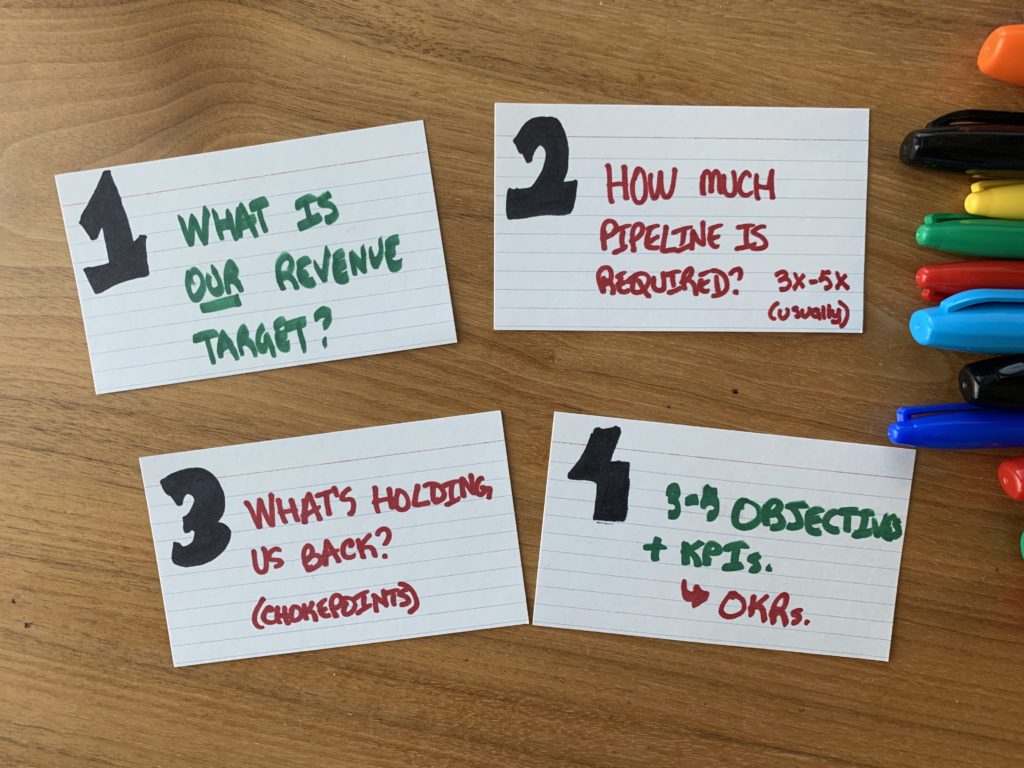It’s officially a new year, and you may be thinking about the growth of your SaaS business. Many of you might have already met with your team to do some strategic planning… BUT how do you know if your strategy and team alignment is any good?
In this blog, I’ll walk through the four essential steps of strategic planning for SaaS that form the backbone of an effective Go-To-Market strategy.
These are the four steps we’ll follow:
- Setting Revenue Targets
- How Much Pipeline You Need
- Finding Your Chokepoints
- Establishing Objectives and KPIs
Navigate Strategic Planning
When I started to hire more senior leadership at ToutApp and even at my time at Marketo as SVP of Strategy in the executive time, we got into a tough conversation on how we would kickstart growth. Every single time these conversations inevitably devolved into the blame game.
“Marketing didn’t generate enough leads”
“Sales didn’t close enough deals.”
“Engineering didn’t deliver on the feature we need.”
It’s par for the course when you have a sophisticated machine. When something is not working and a proper strategy isn’t in place… it leads to pointed fingers. That’s how easily you devolve.
So how do you align your team?
As a Founder of multiple SaaS businesses (and now a SaaS GTM coach) I’ve seen some patterns on effective strategic planning, and narrowed them into four actionable steps.
1. Setting Revenue Targets
The very first thing you and your team must establish is your Revenue Target. Setting revenue targets is imperative when strategizing for the new year. This goal provides clear direction for you and your team to make informed decisions. It also serves as measurable benchmarks that help assess everyone’s performance.
Revenue targets foster a sense of purpose and provide a clear roadmap for resource allocation, investment, and product development. A well-defined revenue target will offer a basis for evaluating the success of marketing and sales efforts, enabling your teams to adjust strategies in real-time to stay on course.
To align your team effectively this new year, ensure that everyone understands the targeted revenue, their role in achieving them, and the broader impact on the company’s overall success. This way you have a motivated and unified team working towards a common goal.
2. How Much Pipeline You Really Need
Your pipeline is the lifeline that fuels your revenue stream. Its health directly influences your ability to achieve targets. When processing your strategic planning, setting a pipeline target is just as important as your revenue target.
Analyze your previous win rates and conversion rates to gain real insight into the number of opportunities actually needed in your pipeline to meet revenue goals. You’ll need to talk to more people or onboard more trial users than you will be closing/converting.
No one has a 100% win rate. Not every lead will progress into a successful conversion. With this in mind, you’ll need to plan for a surplus in opportunities within your pipeline.
For example: If you need to generate 1 million dollars of revenue for your business and each deal is 100K… That means you would need to close 10 opportunities. In order to close those 10 opportunities at a 20% win rate, you would need way more opportunities in the pipeline.
The rule of thumb is to have 3-5X pipeline coverage. Whatever your revenue target is, you need to commit to generating it 3-5X. If you don’t have a robust pipeline, you don’t stand a chance at growth.
3. Finding Your Chokepoints
Chokepoints are obstacles in your business process that impede growth and hinder the attainment of your revenue goals. Every business has chokepoints. Identifying and addressing your chokepoints is crucial when strategic planning for any SaaS business.
In fact, in my SaaS Go-To-Market Coaching Program, we go in-depth into 27 different chokepoints; How to identify them and what to do.
It’s powerful because it forces the team to think about all the different things that are holding the business back from accomplishing the number. Whether it’s a sales funnel issue, operational inefficiency, or a customer support challenge; understanding these obstacles give you and your team clarity on where resources and efforts need to be concentrated.
It also helps you hone in on why you have this chokepoint, who’s responsible, and how to fix it. You and your team members will gain a shared understanding of the hurdles that need overcoming, promoting a collective effort towards resolution. Addressing chokepoints ensures that the entire team is synchronized in their focus and efforts, creating a more resilient foundation for achieving strategic objectives through the year.
4. Establishing Objectives and KPIs
Lastly, what are the 3-5 objectives and KPIs that you’re committed to achieving? Defining you and your team’s objectives serve as the overarching goals that define the company’s direction for the success of this year. The KPIs you set will offer measurable metrics to assess performance and progress towards these objectives throughout the year.
When strategic planning, well-defined objectives and KPIs provide a quantitative and qualitative framework for success evaluation. Regularly tracking and analyzing KPIs enable you and your team to adapt strategies in real-time, making the strategic planning process responsive to market changes.
A good starting point is to identify which objectives you can commit to right now and their related KPIs. My favorite way to do this is using the OKR framework: objectives and key results.
In Conclusion
Strategic planning serves as the foundation for a successful Go-To-Market strategy for your SaaS business. It ensures a deliberate and informed approach to the challenges and opportunities that lie ahead in the new year. From setting revenue targets to fortifying sales pipeline, identifying and addressing chokepoints, and establishing clear objectives and KPIs, each step contributes to a comprehensive and resilient business strategy.
As each of the elements we discussed interconnect, they form the framework for a dynamic, proper GTM strategy. Through meticulous strategic planning and aligning the team around these pillars, you can navigate the complexities of the market, adapt to change, and position themselves for sustainable growth and success. Strategic planning isn’t a static process, but an ongoing commitment to refinement/iteration, ensuring the GTM strategy evolves.
If you’re a SaaS Founder looking to unlock hidden value and set your business up for success in the new year, I invite you to check out my SaaS Go-To-Market Coaching Program. I work to help SaaS Founders like you build incredible growing companies. Inside this program, I work directly with hundreds of SaaS Founders/CEOs in clarifying their ICP, craft a Strategic Narrative and Manifesto, and mobilize a consistent set of GTM activities across key channels to drive organic pipeline.













